Search: Grid Work Run To Middle And Right
 2:40
2:40
Falcon's Grid exercise for running lines
Running straight and changing your running line will make players better attackers and underpins an effective 2 v 1. Dave Walder from Newcastle Falcon's run's through a new style exercise that all coaches can use.
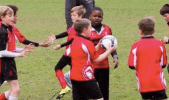 3:27
3:27
Chaos Grid For Multiple Skills
This practise will challenge all players at all levels, originally seen at Bath RFC in 2012 it is been adapted for all players. The coach can change the width and pressure to fit in with the player abilities. The players love this !
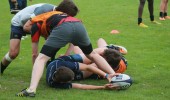 6:14
6:14
Ground work is crucial to retain possession
It is important for players to practice working hard on the ground to get the ball presented back to their team. This session uses bodyweight exercises to practice the movement and enforces it with a conditioned game.
To watch over 2500+ videos join now for free!
JOIN NOW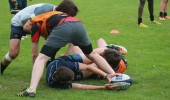 2:10
2:10
Ground Work and Ball Presentation
It is important for players to practice working hard on the ground to get the ball presented back to their team. This session uses bodyweight exercises to practice the movement and enforces it with a conditioned game. Log in to see the full video.
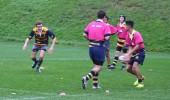 1:47
1:47
Running Lines in Attack
Modern defensive lines are well-organised and hard to break. It depends on the quality execution of attacking fundamentals. A good introduction is 'unders' and 'overs' running lines. Log in to see the full session.
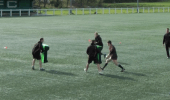 4:04
4:04
Developing running lines to attack
A series of progressions to develop how players attack when "Coming round the corner" from phase play
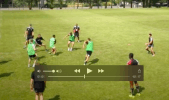 2:06
2:06
Attack Grid For All Ages
Progress your passing practises to make them competitive by adding defenders and ore chaos. This attack grid has lots of flexibility and can be used with players of all ages
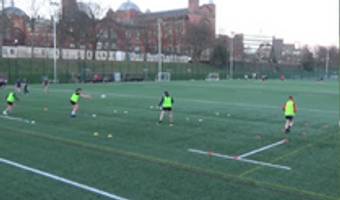 1:26
1:26
Running & Passing Lines
The aim is to fix defenders via the attacking players running straight, and preserving the space on the outside and to stop defenders from drifting. This will support the executing of overlaps.
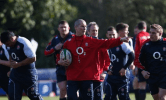 0:33
0:33
Warm Up - Handling Grid
All players running around in a small grid, popping balls to each other. Mix up the types of passes, such as one-handed, high passes low passes etc. Keep them moving before going into more focused stretches.
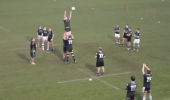 0:28
0:28
7-man - walk-in middle lift
Players walk into the lineout and lift as soon as they are in line. If there are no defending jumpers, the best option is to go straight up in the middle. This requires practice to ensure timing and communication between, the hooker, jumper and lifters is right.
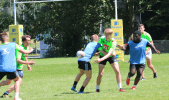 2:13
2:13
Quick Fire Passing Grid
Use as either part of your warm up or as a breakout, this exercise is a high intensity passing challenge. Encourage your players to take ownership of this grid and manage the intensity themselves. Should create lots of fun
 2:06
2:06
L2 - Kicking Development
Skill Practice Description • The teams start with kicking netball i.e. the kicker cannot run and cannot be interfered with. • The player with the ball kicks to work the ball up field and a clean catch behind the goal line is 1 point • Other ways to score are by a drop goal awarding 3 points. • If a breakdown occurs the coach can award a free kick. • The ball carrier can choose to kick to a team mate or try for a target. • The targets can only be aimed at when the targets are in the other half of the pitch. • If the target is missed, possession goes to the other team. • Progression; the kickers must be ‘running’ when kicking the ball. • They must kick within 5 - 8 metres of running. They cannot just keep running with ball in hand. • Players can chip and catch for themselves. • This gives more opportunity for free kicks to be awarded through breakdown in play. • Allow players to discover personal techniques of kicking with both right and left foot. Punt, • Grubber etc. • Discourage throwing the ball up and develop the drop. • Identify those with consistently low outcome percentages and address the relevant technical factors
Scrum Factory - 6. TOP Stick Work
By using sticks and poles, the players are encouraged to self assess their body shape. Peer coaching is also a valuable process in this area and players can work in pairs, quickly learning from each other
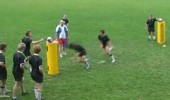 0:04
0:04
Tackle bag grid chase the tackler
A very effective support and conditioning exercise, you can change the space and pace and duration of the work effort
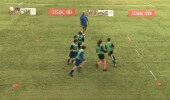
Snake Run and Pass
Players must closely follow the player in front, changing direction with them in a small grid. The front player pop passes to their closest supporter then rejoins the back of the snake.
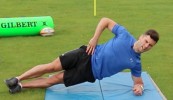 3:13
3:13
Fitness - Core work (Plank)
The core is the building block to every other conditioning exercise. The plank and progressions from the plank are perfect for EVERY rugby player at every level
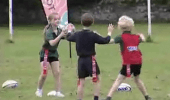 4:39
4:39
Tag Game - Piggy in the Middle
A TAG variation to keep challenging decision-making
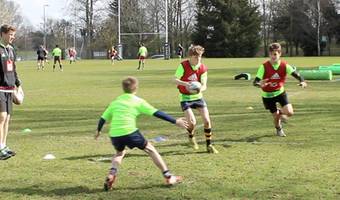 3:21
3:21
Identify Attacking Options
A few drills that will help the attackers identify space in attack and work on how to exploit it!
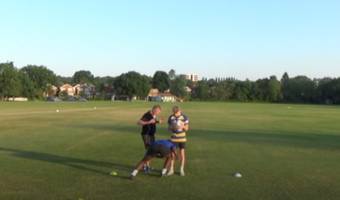 1:45
1:45
Around The Clock Tackling
Set up 5 cones around in a circle. The tackler works out from the first cone to make the tackle. The tackler then backtracks around the next and then comes forward to make the tackle again. Two tackles off the right shoulder, one front on and two off the left shoulder.
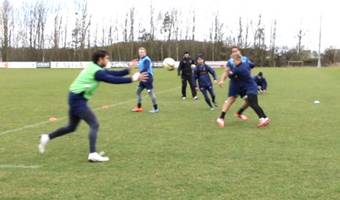 2:43
2:43
Improve Running Lines
Use this simple drill from Newcastle Falcons to improve your player's running lines.
CCRU Game - Capture the Aliens
Description of activity: Two players start with one ball between them, as humans and the rest are aliens. The humans capture the aliens by holding the ball in two hands and touching the alien with the ball. Once an alien has been touched they are turned into a human and can help. When a human has the ball, they cannot move but if they don’t have the ball they can run anywhere inside the grid
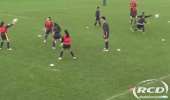 1:02
1:02
STG - Piggy in the Middle
A fun game that will encourage good coordination and decision-making.
 5:44
5:44
Conditioning - Warm-up & Speed Work
Warm up exercises and techniques are used to teach the body the mechanics of movement and potentially how to improve. Accurate technique is important and the trainer uses a variety of games and races to make it fun and competitive
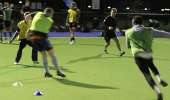 2:40
2:40
Two Channel Passing Exercise
Players work in 3s running around the corner and realigning to attack. Introduce defenders and the need to look up and communicate.
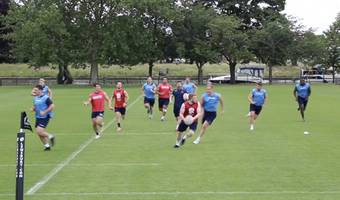 3:14
3:14
Offside Touch
Try this offside touch game from London Scottish. Gets your players working hard whilst developing their technical skills.
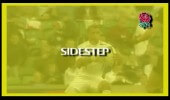 0:43
0:43
Running Skills the sidestep
The sidestep is a key fundamental movement in rugby. This clip outlines the foundations to this movement and is something that can be done at home in isolation or encourage in games and other practises
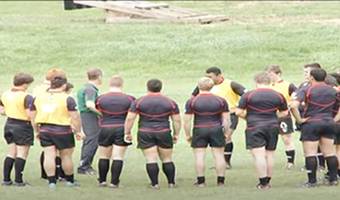 2:16
2:16
L2 - Outflanking Game
Skill Practice Description The objective of this game is to develop the ability to execute the 2 v 1 with consistent efficiency. • The attacking team initially has at least one extra players in order to create an advantage. • There is a channel on each wing in which only 1 defender and 2 attackers may enter at any time. • The attack works the play to get the ball into the outside channel then execute the 2 v 1. • With the extra players, the attack can also develop opportunities to penetrate the defence and so the game in not relying on lateral moment and still incorporates the principles of ‘go forward’. • The progression is to remove the cones and see if the players can still take advantage of the 2 v 1 without the conditions set within the channelled areas . • A further progression would be to even the numbers of each team. Key Coaching Points • Running lines to condense and hold defences in order to outflank. • Running lines in order to disrupt and penetrate the defence line. Relevance to the Game • Attacking players often fail to fix defenders effectively and may drift or over elaborate. • This game will assist in angles of run that fix the last defender
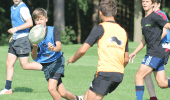 4:24
4:24
Catch and Pass Basics
Northampton saints academy manager Ross Stewart outlines why the basics are so important and runs through some simple techniques
L2 - Scatter Defence Game
Skill Practice Description • Ideal practice for when defences break up later in games or with counter attack decision making. • Attackers stand in front of a numbered cone and ball. • The coach calls a number and all attackers must run around their own numbered cone but whichever number was called, that ball becomes active. • At the same time a colour is called for the defenders and all defenders must turn and run around a cone of that colour. They must however choose different cones. • If a touch is made, the teams swap over roles. • If a try is scored, the attackers stay the same. • First to five tries wins. Key Coaching Points • Spatial awareness • Communication • Quickness of attack at a disorganised defence • Skills to attack space • Footwork and evasion skills • Scanning skills • Decision making • Importance of getting behind defenders Relevance to the Game • Great for coaching counter attacking disorganised defences from different angles. • Any player can be ball carrier and communication is vital as is decision making in identifying space and the best way to attack it successfully • Cones can be placed to shape different types of defence. Organised or scattered
L2 - Colours Touch
Skill Practice Description • Each player is given a colour. • The coach will call out a colour at any time during the game. • The defender/s who have been given that colour need to leave the defence line, run round the nearest cone of that colour and rejoin the defence. • The attack should identify where the spatial opportunity has appeared and take immediate advantage. • The frequency of the call depends on how much the coach wants to work the players. • The coach may call for all players, both defence and attack, to run around an allotted cone colour. • Coach should have two rugby balls to ensure a fast game and a change of defence to attack at times. Key Coaching Points • Visual Acuity-Looking for space • Spatial awareness • Communication - highlighting spaces and mismatches • Evasion skills and footwork • Decision making Relevance to the Game • Spaces are created by the leaving defenders, which the attack has to identify, decide on the appropriate action and attack accordingly. • By using the second ball, the coach can also develop counter attack
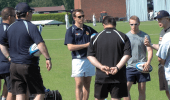 4:56
4:56
Coaching Style of Academy Coaches
The approach and style of coaching is changing and this clip provides some indicators of how some of our academy coaches have altered how they teach players
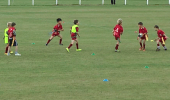 5:09
5:09
Rules of Play - U7s
The rules for the Under 7's in England have changed. The new rules focus on having a game coach who has far more flexibility in making games fun and positive. Official matches are now 4 a side which makes sense. View this video to see how this works in practise
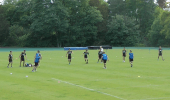 2:53
2:53
Warming up - Options to consider
Should coaches combine games, drills and stretching in their warm ups. The Wasps coaches combine some physical running work and games as an example
 2:27
2:27
England Creating Quick Ball
Eddie Jones manages a game at training focusing on creating quick ball, is this the basis of his attacking game & will it work?
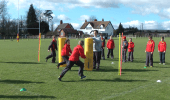 1:16
1:16
Passing - 3 v 2 Static Defenders
Progress to working in 3s against two static defenders. The pressure is on the middle player to hold their depth and perform a quick pass.
 5:37
5:37
Modern Coaching at Oaklands College
This clip provides a summary of how coaches at Oaklands college - Saracens academy partners - approach training and provide some examples of both "What to coach" and "How to coach"
L2 - Penetrating Defence Game
Skill Practice Description • The playing area is marked out in 5m channels. • When defending, players must stay within their channel throughout the game. • The attack must look to penetrate the defence by creating and preserving space. • The defence must use a two handed touch. • There is a 5 tackle turnover rule and once possession is turned over, the defence must get into a channel as the opposition can attack immediately. Key Coaching Points • Support players to hold their opposite number as long as possible before cutting a line to take the pass. • The defender can close the space as far as the edge of their own channel. • If the support player cuts too early or the ball carrier does not move their defender enough, the support player will be touched/tackled. Relevance to the Game • This game will help develop the footwork and running lines to effectively move defenders in order to penetrate the tackle line.
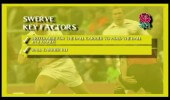 0:38
0:38
Running skills the swerve key points
Running skills coaching points
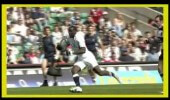 0:28
0:28
Running skills the swerve in action
Running skiils in a game
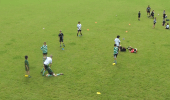 1:45
1:45
Tackle Technique in groups
Give players the opportunity to practice their tackling technique. In groups of five, one player in the middle has four tackle attempts. Make sure everyone has a go and the key points are repeated.
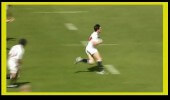 0:29
0:29
Running skills
core running skills in a game
 7:27
7:27
Defence - Defensive Systems
This clip shows past footage, but from this bird’s eye view, it clearly illustrates the organisation required to be a sound defensive team
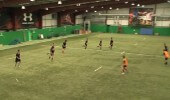 1:28
1:28
Bulldog Touch
Starting with 8 v 2, attackers must find their way through to the other side of the pitch without being tagged. This can help to develop evasive running technique.
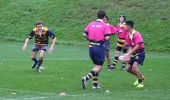 4:18
4:18
Attacking Lines: Unders and Overs
Using different angles of running confuses tacklers and pulls a defensive unit out of line. Learning the skills to both run these lines and pass the ball accurately is key to any ambitious team looking to attack and offload
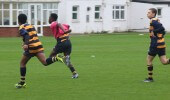 7:01
7:01
Drop off touch - start with a game
Chris Kibble of Esher RFC & Whitgift school says to start your sessions with a game. In this clip Chris runs a game called "Drop touch" where the players run back to a line when they make a touch. This is good for fitness and creating wholes to attack
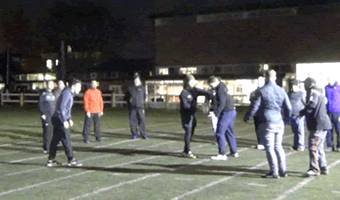 3:16
3:16
Drift Or Blitz Game
The defence have to choose whether to blitz or drift based on the number of attacking players sent out. Tries should only ever be scored out wide!
 3:21
3:21
Three Channel Passing Challenge
Adding pressure to key skills is crucial to improve your players and to practise like you play. This exercise covers a variety of skills but essentially is about accurate passing and fixing defenders
CCRU Game - Passing Pairs
Aim of the game: In pairs, walk, jog or run around the grid, passing to their partner only when they call for the ball. Other players will be obstructing their vision and the flight of the pass, so decisions on when to pass will need to be developed
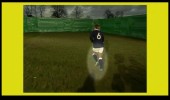 0:31
0:31
Running skills progression
Developing running skills
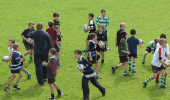 1:24
1:24
Passing in Grid
Players move around in a grid passing to each other. A gentle warm up that is easy to grasp if you have a mixture of talent levels. Involves communication and some handling. Progress to include placing the ball on the ground, then another player picking it up. This is another basic skill that also involves a gentle stretch. You can adapt this with any progression you wish.
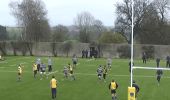 1:00
1:00
Attack Grid - 4 v 2
This continuous exercise puts pressure on your players to think fast and be ruthless in attacking the space. Coaches can change the size of the grid and the number of defenders to make it an easier game
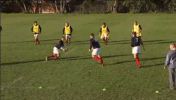 0:39
0:39
Supporting lines - Trail running
A game to challenge how players support with lines of running and communication
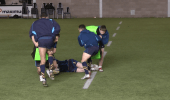 2:46
2:46
Worcester - Live breakdown work
A further progression for players to make decisions with multiple attackers and defenders on what the 1st and 2nd player does at the tackle
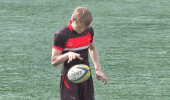 4:46
4:46
Ball Control & Passing
Controlling the ball is a fundamental skill, it may be simple but it is very important. Practise is important and is the foundation to passing and the ability to control and vary your pass
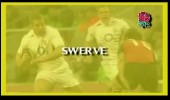 0:16
0:16
Running skills the swerve
Developing core skills
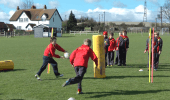 1:02
1:02
Passing - 2 v 1 Static Defender
Now working in just twos, we are concerned with depth, and the timing of the pass. Allow players to practice before adding a static defender. This can be a tackle bag as demonstrated. Players take the ball up to the defender but must complete the pass before they reach it.
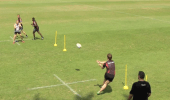 6:24
6:24
Quins - Developing An Accurate Pass
Coaching players to pass with variety and accuracy is one of the most important challenges a coach faces. The Harlequins academy players are presented with some very challenging exercises to help this process
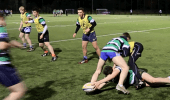 5:13
5:13
Improving support play
Decision making is a tricky skill to coach. Danny Wild the Leeds coach uses conditioned games with breakout technical sessions to improve this process as well as working on some groundwork skills
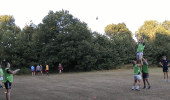 6:01
6:01
Lineout Pods and Movement
The coach progresses the line out onto small units working together, adds in some competition and starts work with some five man options
Tag Game - Numbers Tag
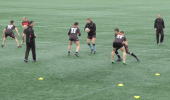 5:57
5:57
Games & drills for tackle technique
The Falcons coaches use a variety of games and breakout drills to progress their tackle technique session. The players respond to questions to vary the style of coaching
 3:41
3:41
Kicking - The Drop / Ball Placement
Dropping the ball properly is considered the main priority for many kickers, if they get the drop right then the other techniques fall into place. Dave Walder from the Newcastle Falcons explains some of the skills
Tag Game - Tag Rugby 1
Tag Game - Tag Rugby 1
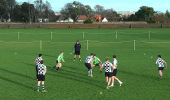 6:02
6:02
Game to coach Depth
Ex England Sevens coach Russell Earnshaw talks through the importance of depth and keeping "Connected". He uses a simple exercise to work on various techniques and makes it competitive to keep the intensity high
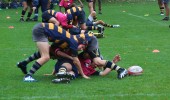 9:20
9:20
Managing the Contact Area
Concentrating on the actions of the tackler and the support player in the moments after a tackle. It's important to practice the correct body position and technique so that the right decision can be made on the pitch.
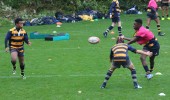 6:03
6:03
Timing the Pass
This exercise looks to develop the decision-making around the timing of a pass, and highlights running at pace and holding depth.
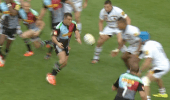 4:50
4:50
Improve your passing
Harlequins pride themselves on their attacking play and the foundation to this philosophy is the quality of their passing. Attack coach Colin Osbourne runs skills session on passing accuracy.
4. Octopus Tig
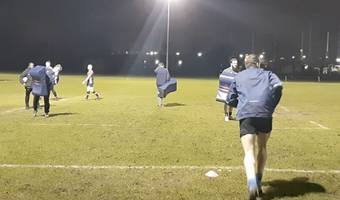 4:03
4:03
Creating The Overlap With Loops
This session is all about creating the overlap through loops whilst your players are working under pressure with the ball in hand.
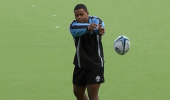 5:42
5:42
Expert Passing
Elite Sixth form players showcase that good passing technique is essential to become a good rugby player. The pass has some simple but very important components that need to be practised
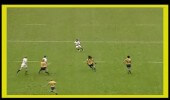
Running skills game footage the sidestep
Skills in action
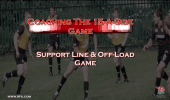 2:46
2:46
L2 - Support Line Breaks & Offloads
Skill Practice Description • The game begins with touch tackles. • Once tackled the ball carrier is allowed to step beyond the tackle line and the support from either side run toward (or attack) the ball. • The pass must be delivered behind the tackle line and not put back in front of the defence, so speed and decision making is vitally important. • Develop the game to grip tackles below the rib cage so the ball can be off loaded. • Progress to full tackles and the ball carrier must fight to keep the ball available. • The support must be aggressive in attacking the ball and getting between and beyond defenders. • When in full contact and the ball carrier cannot off load immediately, rucks and mauls may be played. Key Coaching Points • The game relies on good support play in all areas. This game illustrates the need for consistent and aggressive support. • The supporting players need to work for the ball carrier and attack the ball, getting in behind the defence for an off load. • Once the tackle line has been breached the attack must not allow the defence time to reorganise. • When progressed to full contact, the demand on decision making increases
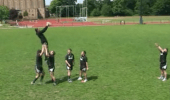 0:09
0:09
Full lineout practice - middle then back
Unopposed practice to develop calls and movement patterns
CCRU Game - Piggy in the middle
Description of activity: In groups of 3 v 1 the three attacking players have the ball and pass it around to each other trying to keep it from the defender. Give the attacking players a target i.e. make 10 successful passes. The defender tries to either intercept the pass or force a poor passes where the ball goes to the ground or outside of the marked area
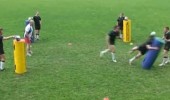 0:35
0:35
Tackle bag grid chase the tackler 2
a high intensity support and conditioning drill in a small space, that you can manage
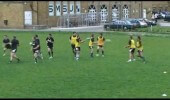 0:19
0:19
Handling relay right to left
All players need to timing the pass and communicating at all times
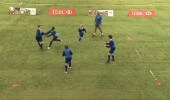 0:42
0:42
Piggy in the Middle - 4v1
Develop young players' quick passing and decision-making skills.

Running Skills in a game
Watch the skills in action

Running skills the sidestep 1
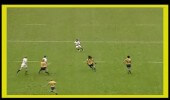
Running skills game footage the sidestep 2
Watching core skills in action
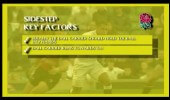
Running skills key coaching points
What are the key coaching points
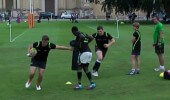 3:20
3:20
How to manage contact
Managing contact on your own terms is vital to most teams. The Saints academy manager explains and showcases some of the fundamental skills they work on
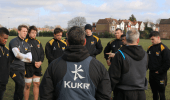 4:03
4:03
Wasps - Footwork The Key To Big Tackles
Aggressive tackling is fundamental to Wasps performances and their players physicality is part of their DNA. Brad Davis overseas a tackle technique session that will change your approach to coaching the tackle
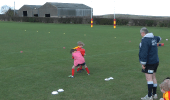 2:11
2:11
Tackle Technique - Head Position
With the attacker holding a tackle shield, and running either left or right of the defender, the key point of this drill is ensure the tackler's head is on the right side.
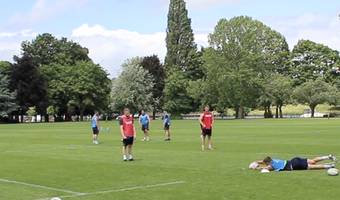 3:08
3:08
Improve Ball Presentation and Handling
This exercise from London Scottish works to maintain high levels of both ball presentation and handling skills at the same time.
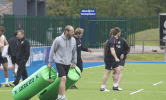 3:36
3:36
Planning your session & set up
Spending a few minutes to set up will improve the quality of your session considerably. Mixing games and breakout drills keeps the training fresh and interesting while the progressions you use reinforce the skills you are teaching
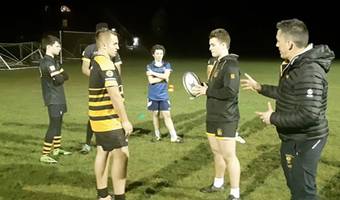 4:54
4:54
1v1 Evasion Skills
This video takes you through the skills to use in a 1v1. Use the fend, ball transfer and footwork to beat the man.
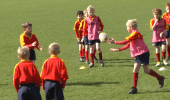 2:17
2:17
Passing in 2s
Working in pairs, the key point of this passing drill is for the support runner to be deep and taking the ball at pace.
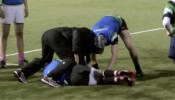 1:49
1:49
Decision making at the breakdown - Ruck touch
Coaching players to make the right decision at the breakdown is a complex challenge for coaches. In this video Danny Wild from Leeds carnegie uses a whole - part - whole approach to help improve the players decision making
L2 - Tactical Scoring Game
Skill Practice Description • Play 7v7 in the game area but mark different scoring zones along the try lines (use coloured cones). • Mark 5 metres in from each try line with red markers and if a try is scored in either of these areas then it will be worth 8pts. • The next two 5 metre zones moving inwards would be worth 5 pts and the rest of the try line worth 3pts. • This should challenge the ability to outflank or penetrate in order to build a score. • It may be that the defenders primarily defend in the outside channels leaving the middle with more space. • The attack can then take advantage of this new situation, scoring in the middle zone. • Thus identifying the weaknesses of the defence. Key Coaching Points • Spatial awareness • Communication • Quickness of attack at a disorganised defence • Skills to attack space • Footwork and evasion skills • Scanning skills • Decision making Relevance to the Game • This game challenges the decision making of both attack and defence. • If for example a turn over occurs, which score area does the attack target? • Which area does the defence cover and defend first?
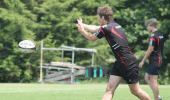 4:17
4:17
Attacking Ability at 13
Outside centres who have great attacking awareness and distribution skills are integral to teams who like to exploit quick ball by going wide. If these players are only able to run hard lines, then there are going to be missed opportunities out wide. Here, we highlight some great passing and attack play in the Premiership, as well as some ideas for you to use with your players.
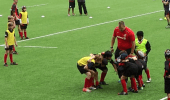 6:19
6:19
New Rules of Play Under 10s
The New rules for the Under 10's are not compulsory for all clubs however they are explained in this video clip and there are some good practical examples. If you do not apply these rules then you can still use them for some conditions for training
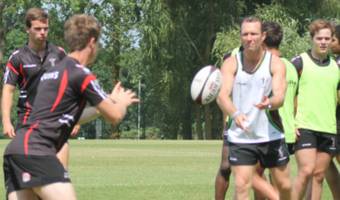 3:05
3:05
3 v 2 How to Fix Defenders
Running straight & fixing defenders is a skill that all players must learn and learn at an early age. The top players regularly practise this skill to maintain accuracy. This is the building block to scoring tries
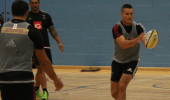 3:05
3:05
Quins - Tips On Fixing Defenders
The best players and the best teams can all run straight and fix defenders. For some it is the most important technique to master. This clip features three different practises
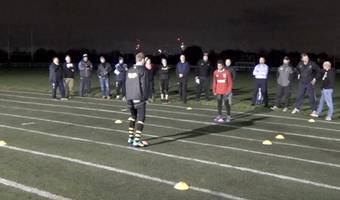 3:14
3:14
Quick and Fun Agility Exercises
In this video Ross Hanbury takes a detailed look at two quick and fun agility exercises to run with your players.
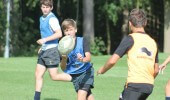 4:08
4:08
Using Games to Improve Support Play
Great tries are often the result of great support play. Coaches are now using more games in their training with set constraints put in to dictate what the coach wants to work on
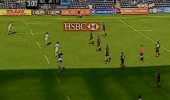 0:24
0:24
Sevens - Offloads 2
To execute an offload you need to have support players in the right area, here the ball carrier knows he has support and is able to take a risk and offload out of the back of the tackle. Prior to the offload the ball carrier works hard to stay on his feet. Key factor : Leg drive - Twist and work the body in contact - Control ball one handed - Communication from support players
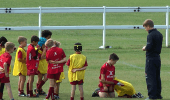 7:59
7:59
Learning to Tackle - Under 9's & Up
The RFU new rules of play have completely changed the approach of introducing young players to tackling. A phased approach may challenge previous methods however by viewing the practical session on this video you can see how the process works
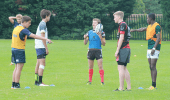 5:39
5:39
Drift Defence from Breakdown
After starting with a defence-focused game, this drill can be used to focus on organising a drift defence from the breakdown. The four defenders touch all cones in the tackle area to simulate chaos before getting into position.
 5:51
5:51
Games for Coaching - Examples
Coaches often request ideas to help them plan sessions. Here are some examples of the conditions that coaches can apply to make training more challenging and enjoyable

